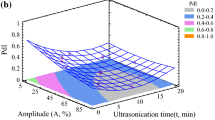Abstract
This paper presents the UV synthesis in miniemulsion of nanoparticles from hexyl acrylate monomers using radical photoinitiator type I benzoin methyl ether. The optimization of such a miniemulsion composition is studied to produce monodisperse nanoparticles with a mean size d p inferior to 200 nm after photopolymerization of the droplets. The correlation between the size distributions of the droplets and the corresponding nanoparticles was verified. Therefore, a composite design was built as regards to the amount of the surfactant (sodium dodecyl sulfate), the co-stabilizer (pentadecane), and the monomer (hexyl acrylate) in order to model the mean size and the polydispersity of the miniemulsion droplets. A range of monodisperse droplets size between 150 and 175 nm was achieved. After UV irradiation, high monomer conversion yield (>90 %) was reached leading to nanoparticles with mean size ranging from 100 to 165 nm. These hexyl acrylate nanoparticles have been obtained after 10 min of irradiation, offering new opportunities for nanoparticles synthesis in enclosed and/or plastic vessels.






Similar content being viewed by others
Abbreviations
- AMPS:
-
2-Acrylamide-2-methyl propane sulfonic acid
- BME:
-
Benzoin methyl ether
- d d :
-
Droplet diameter
- HA:
-
Hexyl acrylate
- d p :
-
Nanoparticle diameter
- PdIDLS :
-
Polydispersity index
- C15 :
-
Pentadecane
- SDS:
-
Sodium dodecyl sulfate
References
Claus B et al (2010) Micro- and Nanopatterning of Surfaces Employing Self Assembly of Nanoparticles and Its Application in Biotechnology and Biomedical Engineering. Lithography, Book edited by: Mickael Wang. ISBN: 978-953-307-064-3
Asua JM (2002) Miniemulsion polymerization. Prog Polym Sci 27(7):1283–1346
Larpent C, Tadros TF (1991) Preparation of microlatex dispersions using oil-in-water microemulsions. Colloid Polym Sci 269(11):1171–1183
Capek I (2001) On the role of oil-soluble initiators in the radical polymerization of micellar systems. Adv Colloid Interf Sci 91(2):295–334
Antonietti M, Landfester K (2002) Polyreactions in miniemulsions. Prog Polym Sci 27(4):689–757
Li T et al (2011) Study of emulsion polymerization stabilized by amphiphilic polymer nanoparticles. Colloid Polym Sci 289(14):1543–1551
Qi D, Cao Z, Ziener U (2014) Recent advances in the preparation of hybrid nanoparticles in miniemulsions. Adv Colloid Interf Sci 211:47–62
Kundu P et al (2013) Stability of oil-in-water macro-emulsion with anionic surfactant: Effect of electrolytes and temperature. Chem Eng Sci 102:176–185
Jahanzad F et al (2007) Hybrid polymer particles by miniemulsion polymerisation. Colloids Surf A Physicochem Eng Asp 302(1–3):424–429
Babaç C et al (2004) Production of nanoparticles of methyl methacrylate and butyl methacrylate copolymers by microemulsion polymerization in the presence of maleic acid terminated poly(N-acetylethylenimine) macromonomers as cosurfactant. Eur Polym J 40(8):1947–1952
Anton N, Vandamme T (2011) Nano-emulsions and micro-emulsions: clarifications of the critical differences. Pharm Res 28(5):978–985
Schork FJ et al (2005) Miniemulsion polymerization. Adv Polym Sci 175:129–255
Fontenot K, Schork FJ (1993) Batch polymerization of methyl methacrylate in mini/macroemulsions. J Appl Polym Sci 49(4):633–655
Landfester K (2009) Miniemulsion polymerization and the structure of polymer and hybrid nanoparticles. Angewante Chemie-International Edition, 48(25): p.4488-4507
Landfester K et al (1999) Formulation and stability mechanisms of polymerizable miniemulsions. Macromolecules 32(16):5222–5228
Landfester K (2000) Recent developments in miniemulsions—formation and stability mechanisms. Macromol Symp 150(1):171–178
Hecht L et al (2011) Surfactant concentration regime in miniemulsion polymerization for the formation of MMA nanodroplets by high-pressure homogenization. Langmuir 27:2279–2285
Xu X et al (1999) Microemulsion polymerization of methyl methacrylate initiated with BPO. Eur Polym J 35(11):1975–1978
Chen J, Zhang Z (2007) Radiation-induced polymerization of methyl methacrylate in microemulsion with high monomer content. Eur Polym J 43(4):1188–1194
Capek I (2000) Photopolymerization of alkyl(meth)acrylates and polyoxyethylene macromonomers in fine emulsions. Eur Polym J 36(2):255–263
Capek I, Fouassier JP (1997) Kinetics of photopolymerization of butyl acrylate in direct micelles. Eur Polym J 33(2):173–181
Peinado C et al (2006) Photoinitiated polymerization in bicontinuous microemulsions: fluorescence monitoring. J Polym Sci A Polym Chem 44(18):5291–5303
David G et al (2002) Microemulsion photopolymerization of methacrylates stabilized with sodium dodecyl sulfate and poly(N-acetylethylenimine) macromonomers. Eur Polym J 38(1):73–78
Dou J et al (2010) Magnetic nanoparticles encapsulated latexes prepared with photo-initiated miniemulsion polymerization. Colloid Polym Sci 288(18):1751–1756
Roose P et al (2014) UV-nanoparticles: photopolymerized polymer colloids from aqueous dispersions of acrylated oligomers. Prog Org Coat 77(10):1569–1576
Chemtob A et al (2010) Photoinduced miniemulsion polymerization. Colloid Polym Sci 288(5):579–587
Hoijemberg PA, Chemtob A, Croutxé-Barghorn C (2011) Two routes towards photoinitiator-free photopolymerization in miniemulsion: acrylate self-initiation and photoactive surfactant. Macromol Chem Phys 212(22):2417–2422
Wang Y, Yang W (2004) MMA/DVB emulsion surface graft polymerization initiated by UV light. Langmuir 20(15):6225–6231
Wang Y et al (2005) Directly fabricating monolayer nanoparticles on a polymer surface by UV-induced MMA/DVB microemulsion graft polymerizationmacromolecular rapid communications 26(2). Macromol Rapid Commun 26(2):87–92
Ladner Y et al (2012) New "one-step" method for the simultaneous synthesis and anchoring of organic monolith inside COC microchip channels. Lab Chip 12(9):1680–1685
Ladner Y, Crétier G, Faure K (2012) Electrochromatography on acrylate-based monolith in cyclic olefin copolymer microchip: a cost-effective and easy-to-use technology. Electrophoresis 33(19-20):3087–3094
Acknowledgments
The authors acknowledge financial support by French National Research Agency (ANR) through Nanochrom project (11-JS09-017-01).
Author information
Authors and Affiliations
Corresponding author
Electronic supplementary material
Below is the link to the electronic supplementary material.
Supplementary data S1
(DOC 61 kb)
Supplementary data S2
(DOC 28 kb)
Supplementary data S3
(DOC 35 kb)
Rights and permissions
About this article
Cite this article
Saadé, J., Bordes, C., Raffin, G. et al. Response surface optimization of miniemulsion: application to UV synthesis of hexyl acrylate nanoparticles. Colloid Polym Sci 294, 27–36 (2016). https://doi.org/10.1007/s00396-015-3778-2
Received:
Revised:
Accepted:
Published:
Issue Date:
DOI: https://doi.org/10.1007/s00396-015-3778-2




